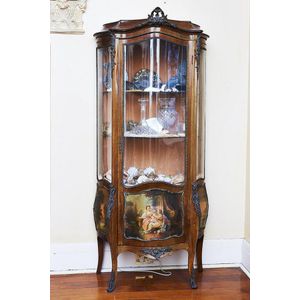Louis XVI Style Vernis Martin Vitrines with Gilt Mounts
You must be a subscriber, and be logged in to view price and dealer details.
Subscribe Now to view actual auction price for this item
When you subscribe, you have the option of setting the currency in which to display prices to $Au, $US, $NZ or Stg.
- Bombe Front - More commonly associated with a dome shaped dessert, "bombe" in furniture parlance means "puffed out". In profile the piece is serpentine shaped, narrow at the top, swelling out towards the middle and continuing to the floor, though sometimes it narrowed again at the foot. Drawer fronts are curved in section. Bombe pieces are often highly decorated with marquetry inlay, or veneered and set with brass or ormolu mounts. The most common use of the word, is in the description of the 'bombe commode'.
The bombe design was particularly popular in the 18th century, during the reign of Louis XIV, when it was used to create furniture pieces with a curved, rounded bulging shape. This design was used on furniture in many styles, including Baroque, Louis XIV, Louis XV and Louis XVI. The bombe chest is one of the most iconic furniture piece featuring this design. They were usually made of precious woods like mahogany, rosewood, and walnut, and feature elaborate inlay, gilded ornaments and ormolu. Other items of furniture where the bombe design can be seen include cabinets, commodes, and desks. - Mounts - Mounts are used to describe bronze, brass and ormolu adornments on furniture especially quality furniture in the rococo and classical revival style, and are also the cabinet makers' name for the metal fittings on furniture, such as hinges, locks and handles, and metal edges and guards which protect furniture from damage.
- Manner of .... / Style of ..... - A cataloguing term where the item, in the opinion of the cataloguer is a work in the style of the artist, craftsman or designer, possibly of a later period.
- Vernis Martin - A generic name for a type of lacquer finish applied to furniture and a multitude of small articles, giving a brilliant translucent finish, imitating the Chinese and Japanese lacquer finishes on furniture imported into France during the Louis XV period..
Usually the surface to which the lacquer is applied was embellished with painted decoration of a classical scene.
The name is derived from the inventors, Simon-Etienne Martin and his two brothers, a distinguished family of French artist-artificers of the 18th century, who refined and perfected the technique, and were granted a monopoly in its manufacture in 1730. - Bronze - An alloy of copper and tin, traditionally in the proportions of about 9 parts of copper to 1 part of tin.
The discovery of bronze in Western Asia in the 4th century enabled people to create metal objects which were superior to those previoulsy possible because of its strength and hardness, and it has been used throughout the world for weapons, coins, tools, statuary and other decorative items.
It is very fluid in a molten state, and its hardness, strength when set, and non-corrosive properties makes it most suitable for casting sculpture. - Mahogany - Mahogany is a dense, close grained red-coloured timber from the West Indies and Central America. It was first imported into Europe in the the early 18th century and its use continued through the 19th century. It was popular for furniture making because of its strength, the wide boards available, the distinctive grain on some boards, termed flame mahogany and the rich warm colour of the timber when it was polished.. The "flame" was produced where a limb grew out from the trunk of the tree, and this timber was usually sliced into veneers for feature panels on doors, backs and cornices.
Some terms used to describe mahogany relate to the country from which it originally came, such as "Cuban" mahogany, "Honduras" mahogany etc. However unless the wood has been tested the names assigned are more a selling feature, rather than a true indication of the timber's origin.
This item has been included into following indexes:
Visually similar items

A Louis XV style corner vitrine, with a concave cornice above a single glazed curved door opening to a mirror lined interior with glass shelving, the lower cupboard with a burr walnut strung panel, a shaped apron and raised on slender cabriole legs, with g

A Biedermeier mahogany display cabinet, circa 1850, set with a single glazed door with shaped sides below a scroll and foliate Crown, the base set with a single drawer and standing on square feet. Height 189 cm. Length 85 cm. Depth 43 cm

A French Empire style mahogany vitrine, 19th century, with a gilt gallery above a shaped pediment, a single partially glazed door above an inlaid panel festooned with ribbons instruments and flora and enclosing internal shelving, the sides also glazed and

A French mahogany Louis XV-style vitrine, circa 1940s, a shaped pediment above conforming glazed sides and a full length glazed and bowed door enclosing a mirror backed display space with two glass shelves, with a shaped apron and sides, and raised upon re
